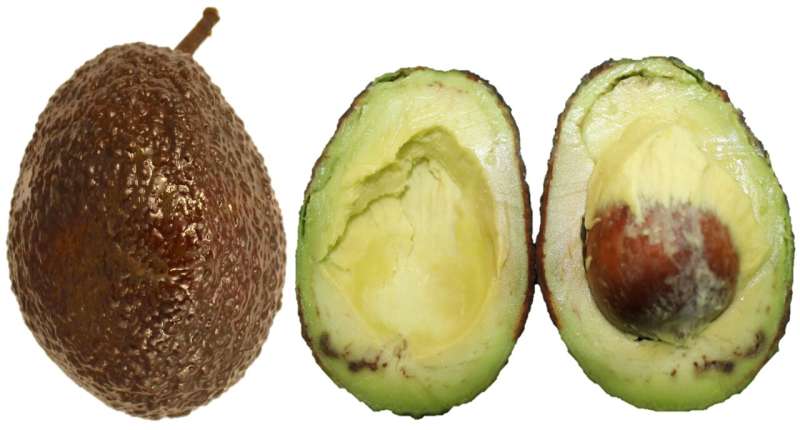This article has been reviewed according to Science X's editorial process and policies. Editors have highlighted the following attributes while ensuring the content's credibility:
fact-checked
trusted source
proofread
A chitosan-based coating to help avocados stay fresh

Smashed on toast, creamed in guacamole or blended into salad dressing, avocados always seem to be popular. However, the fruits are notoriously finicky, going from pale green and firm to brown and mushy in the blink of an eye. Now, researchers in ACS Food Science & Technology report a chitosan-based coating that preserves them for longer periods. The team also developed an imaging technique to quickly predict their shelf life.
To tell if avocados are ripe, most people gently squeeze them, and a little sponginess indicates that they're mature. Producers conduct similar assessments to determine which avocados can withstand transportation to grocery stores. Despite these tests, some of them spoil prematurely.
Therefore, researchers have developed techniques to delay ripening, using compounds such as 1-methyl-cyclopropene (1-MCP). And more recently, studies have shown that naturally-derived chitosan—a biomaterial derived from shellfish exoskeletons—imparts antimicrobial activity when applied as a coating to fruits, including avocados. So, Angie Homez-Jara, Angelica Sandoval-Aldana and colleagues wanted to compare the effectiveness of the two preservation methods on avocados' quality and shelf life.
The researchers treated commercially mature Hass avocados with either gaseous 1-MCP or water-based solutions that contained different concentrations of chitosan. Mimicking realistic transportation conditions, treated and untreated avocados were chilled at 41 degrees Fahrenheit for 21 days and then moved to room temperature to simulate a grocery store environment, until they were rotten.
Untreated samples and those treated with either 1-MCP or 1% chitosan-based coating were at optimal ripeness for 6 days. Fruits treated with a 1.5% chitosan-based coating were best for 12 days. However, these samples also had uneven firmness once they were ripe, as well as green and purplish spots in the peel, which the researchers say shows that the chitosan coating could be improved in the future.
Throughout the study, the researchers also imaged the entire surface of the fruits with hyperspectral cameras in the visible and near-infrared spectrum. Then the reflectance data from the images were compared to the avocados' firmness, peel color, oxygen consumption and weight loss, using a number of computer models.
Two machine learning models best explained the changes that occurred during the avocados' ripening and could predict their remaining shelf life. The researchers say that their chitosan-based coating and prediction technique could help improve the shelf life and quality of avocados for sale.
More information: Angie Homez-Jara et al, Postharvest Treatments of Hass Avocado (Persea americana Mill.) and Estimation of Its Quality Using Hyperspectral Imaging (HSI), ACS Food Science & Technology (2023). DOI: 10.1021/acsfoodscitech.3c00084
Provided by American Chemical Society
















